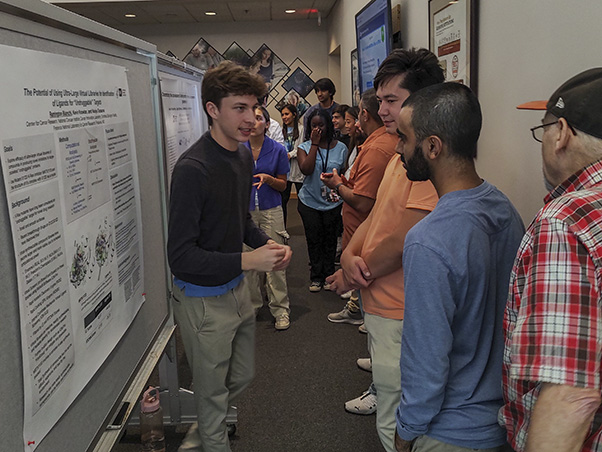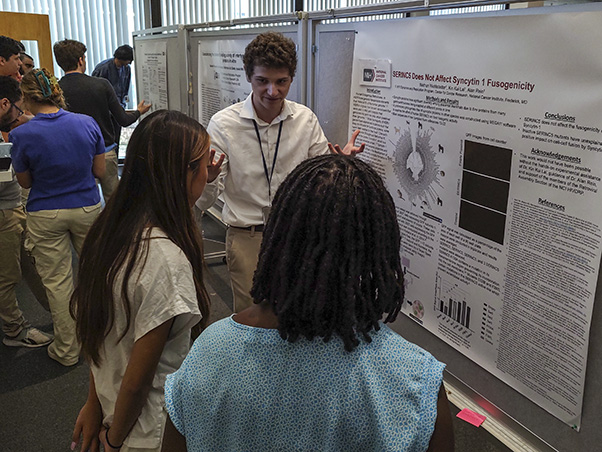Building 549’s atrium was abnormally crowded one late summer day. Like the cicadas buzzing just outside the building, the room thrummed with excitement, dozens of conversations going at once. The noise was so loud that it was hard to hear someone speaking even a few paces away.
Student Poster Day had returned to the NCI Frederick campus, making its first appearance since the apprehensive days of early 2020.
Interns ranging from seniors in high school to seniors in college stood among a gallery of posters—their handiwork—explaining their research projects and data to other scientists. Despite any self-consciousness they may have felt, the enthusiasm was palpable.
For the younger interns, it was their first time sharing their research publicly, just a mere eight weeks since most of them had started on the job. There hadn’t been much time to run experiments and get meaningful results, even when working full-time, but they’d managed to do it.
Some interns said their mentors had encouraged them to participate and coached them in preparation for the big day. Others readily seized what they saw as an exciting opportunity.
“I want to present because I know that I’ve learned a lot over the summer on [the project] and wanted to gain as much as I could from the research and the overall internship experience,” said Tanirika Choudhry, an intern in the Werner H. Kirsten (WHK) program under mentor Brandon Keele, Ph.D., at the event.
Getting the research ready for presentation was far from simple, however. The mentors assigned the interns to interesting laboratory projects, but the interns had to grasp advanced scientific principles and get up to speed quickly. On top of that, some learned to write code, use new software, or execute laboratory procedures.
And, of course, in addition to creating their posters, the interns were responsible for obtaining and curating their data, working with other scientists in the lab to do so. Given all that could go wrong, the process was easier said than done.
“It was the week before. The compounds hadn’t come in yet, and I didn’t have my [viable cell] assays running already,” said Remington “Remi” Bianchi, a WHK intern under mentor Nadya Tarasova, Ph.D., at the event.
Recalling the moment, he added, “I was like, ... ‘I’m still making my poster, and I have no actual results to discuss!’”
Yet he, like the other interns, pulled it off. He attended the event with a completed poster, data included. Attendees who approached him were treated to an in-depth discussion on his project, the use of computerized libraries of molecules to identify potential new drugs for hard-to-treat cancers.
For Choudhry, who said she worked with her mentor and labmates to prepare, the event went much the same. With a scientific mastery beyond that of most high-schoolers, she confidently described her work on genetically labeling certain viruses to track the cells they infect in laboratory studies.
Similar scenes played out across the room. Many interns spoke the scientific parlance without stumbling, displaying an almost startling lack of nervousness as the event continued. It seemed a testament to all their practice and learning so far. Simply put, they knew their stuff.
Some also tried to keep a level perspective as they spoke to attendees, which may have contributed to their confidence.
“It’s all about the process, especially with an intern,” Bianchi said, pointing out that his responsibility was to learn just as much as it was to contribute.
Meanwhile, Choudhry noted, “I’ve been able to have a lot of good conversations with people. ... It’s my first time doing something like this, so I’m just taking it as a learning opportunity.”
Perhaps it was also their belief that the best is yet to come. Spurred on by the experience, some of the interns were keen to see where their research goes and, equally, where they’ll go with a scientific career.
Summing up the opportunity so far, Bianchi said, “It has definitely surpassed my expectations.”
Samuel Lopez leads the editorial team in Scientific Publications, Graphics & Media (SPGM). He writes for newsletters; informally serves as an institutional historian; and edits scientific manuscripts, corporate documents, and sundry other written media. SPGM is the creative services department and hub for editing, illustration, graphic design, formatting, multimedia, and training in these areas.







